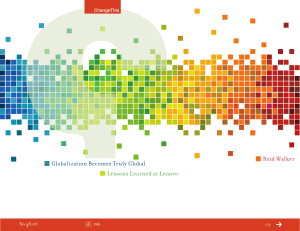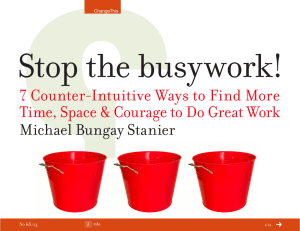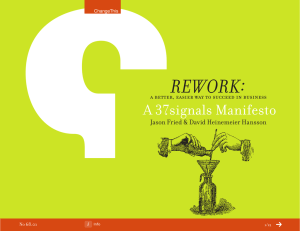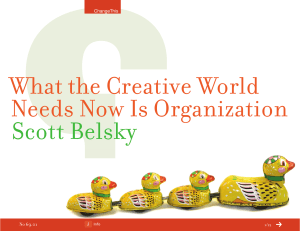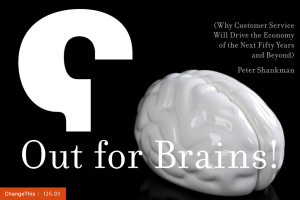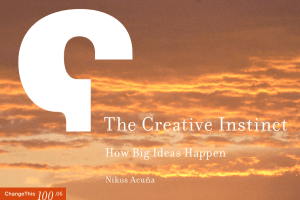The Seven Myths of Hyper-Social Organizations Why Human 1.0 is Key Francois Gossieaux
advertisement
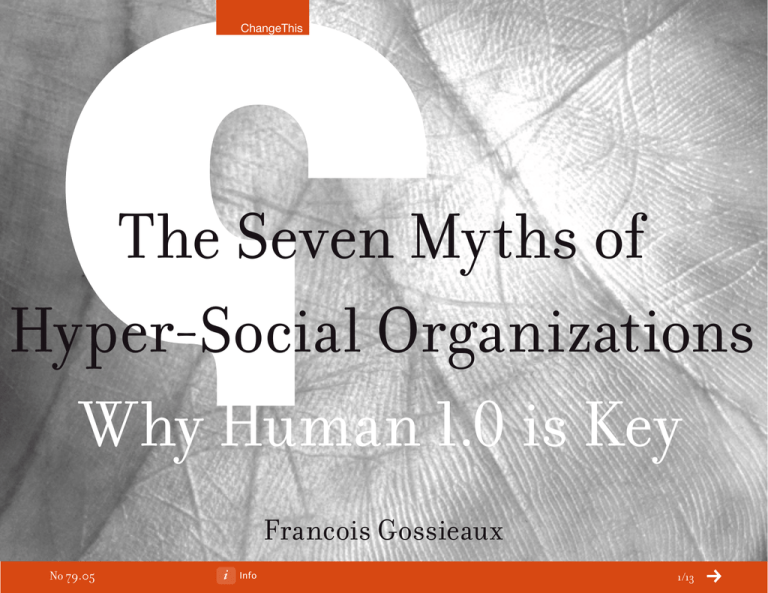
ChangeThis The Seven Myths of Hyper-Social Organizations Why Human 1.0 is Key Francois Gossieaux No 79.05 Info 1/13 ChangeThis With the rise of social media providing a massive platform for participation and a social infrastructure that is finally catching up with the conference infrastructure, the social element is reentering commerce and business with a vengeance. People can now claim a share of voices that is equal or larger than that of companies, employees can now develop support networks that cross the traditional hierarchical organization charts, and people can once again behave the way they were hardwired to behave in business and commerce—tribally, humanly, and socially. To understand the changes that are afoot in the world of business you are better off understanding Human 1.0, which took tens of thousands of years to develop, rather than Web 2.0, which took merely a decade. Most companies that are thinking about leveraging social media as part of their business—whether in marketing, customer service, new product innovation, employee communications, or public relations—see it as a new way to reach people. They focus on the media in social media. Missing from this strategy is the idea that social media is not about media, nor is it about Web 2.0 tools or the new rules that govern them. No 79.05 Info 2/13 ChangeThis Social media is all about our social natures growing to levels never before seen in human history. Social media is about certain Human 1.0 behaviors finally taking hold in the business world, where they’ve long been absent. We may be living in a Web 2.0 world, but the behaviors that this new environment triggers are solidly Human 1.0. These tools are creating and demanding a platform of participation that is slowly changing the way companies work both internally and externally. No longer are communications limited to the channels of the traditional command-and-control hierarchy. People now find ways to communicate and help one another across conventional reporting structures. Social media is what has enabled the hardwired Human 1.0 behaviors to scale to levels never seen before in business. We call it Hyper-Sociality. Through being Hyper-Social, we can help others and be helped. We can form tribes again—except that this time our tribes will not be bound by geography and we can belong to multiple tribes at the same time. We may be living in a Web 2.0 world, but the behaviors that this new environment triggers are solidly Human 1.0. No 79.05 Info 3/13 ChangeThis The Hyper-Social Organization: an Anti-Fad Web 2.0/social media is a massive platform of participation that allows the Hyper-Social wave to sweep across everyone—your employees, customers, prospects, and detractors—on a scale that is beyond anything that we’ve ever seen before. In effect, social media gives everyone a voice equal to that of your company. The main driver for much of what is happening in business today is not technology, nor is it a fundamental change in media. What is really happening is that social media, connectivity, and always-on technology have allowed the Hyper-Social Human 1.0 to expand to levels never seen before and reenter business with a vengeance. That makes Hyper-Sociality the reverse of a fad in some ways. It’s not something new, as humans have always behaved socially. Hyper-social organizations realize that social media fundamentally changes the way they identify, develop, educate and support their customers. They won’t simply think of social media as a new channel to reach and interact with customers. Hyper-social organizations know that business objectives have not changed since Peter Drucker described them, saying “Because the purpose of business is to create a customer, the business enterprise has two—only two—basic functions: marketing and innovation. Marketing and innovation produce results; all the rest are costs. Marketing is the distinguishing, unique function of business.” The end goal of business has not changed; it is still to create a customer. It is everything in between, the path to that goal, that has changed! No 79.05 Info 4/13 ChangeThis Why Customers No Longer Listen to Companies For companies to have successful communications, reciprocity must exist. Because we have a platform of participation called social media, a platform that allows people to engage with other people in conversations that are truly reciprocal, it is not wonder that two-thirds of all buying decisions are based on information that does not come from the company selling the product or service. When people have a choice between a reciprocal conversation and a nonreciprocal one, they will tune out the one that is not. For businesses to be successful they must understand the role of reciprocity in everything they do—from internal/external communications to new product development and customer support. Business executives need to stop thinking in terms of abstract business concepts and evaluate constantly what they do in the context of what makes people tick (in groups, not as individuals). Businesses must ask these questions: »» Can we create a reliable story around what we do? »» Can we create symbols, rituals, or culture around our offerings? »» Can we create and mobilize tribes to help our cause? »» Can we leverage the power of every individual within our company to humanize our brand and create more passion around what we do? No 79.05 Info 5/13 ChangeThis Successfully Shifting To Hyper-Social: Debunking the 7 Myths The Hyper-Social shift is inevitable for businesses, and is therefore important to understand and master. Studying hundreds of companies for our annual “Tribalization of Business” research, we determined there is a disturbingly high rate of incidence of missteps that companies make as they transition to Hyper-Sociality. We’ve discovered seven key myths that lead to Hyper-Social pitfalls: Myth 1: Build It and They Will (Continue to) Come: The mere presence of an online venue does not automatically create a community to populate it. That’s why the Internet is littered with communities that are devoid of any recent activity and blogs with no comments that were last updated months ago. You surely have seen some of these virtual ghost towns. After a while, they fail to meet the expectations of the companies that set them up, and they are usually taken down. Organizations think that if they build online communities for their target customers, people will show up and populate the forums, the blogs, and other content-related areas. What they miss is valuable content. Valuable content keeps communities going and in most cases, the content should be professionally developed in order to keep the community going. No 79.05 Info 6/13 ChangeThis The “build it and they will come” vision does not guarantee that anyone will show up. Companies must tap into a shared passion and deeply consider what they are trying to deliver to their tribe, and then build accordingly. Let the visitors add to the community, change it and ultimately take it over for more success. Myth 2: The “Not Invented Here” Syndrome: This is the second largest cause of Hyper-Social program failures. In a typical “not invented here” scenario, company executives first read or hear about the amazing benefits that other companies have gained by leveraging social media and communities (of course, they never hear about failures.) Then they get the sense that their company is falling behind, and they “empower” their marketing team or their IT team to initiate Hyper-Social programs. But typically they never take time to do an ecosystem scan to see whether the tribes that they might want to engage with are already congregating somewhere else. If your tribes already have a home, trying to get them to move (no matter how good the web design/site) is akin to focusing your whole go-to-market strategy on switching customers who use competitive products. It can be done if your competitor is offering subpar products, but it is rarely a successful stand-alone strategy. Similarly, trying to get an existing community to move to the site you’ve provided is not likely to be successful. Companies that are open to the possibility of partnering with other communities will have a HyperSocial advantage. In the Tribalization of Business Study we found that many organizations considered partnering with existing communities (25%), complementary vendors (13%), or fans (20%). Of those that considered partnering less than 50 % ended up doing it. We predict that number to grow as more dominant communities emerge on the horizon and executives start realizing that they cannot be Hyper-Social without partnering. No 79.05 Info 7/13 ChangeThis Myth 3: Let’s Keep It Small so It Doesn’t Move the Needle Many Hyper-Social efforts are too small to make a difference to the business processes that they are supposed to support. Too often companies have a culture of using test or pilot programs before launching broadly and this harms the hyper-social effect. The second reason companies fail to scale is that they are chronically underfunding their Hyper-Social projects—especially from a human resources point of view. If you rely on having tens of thousands or millions of customers to achieve your revenue numbers, you need Hyper-Social initiatives that are commensurate with those numbers. This is especially true if the purpose of your Hyper-Social activity is to amplify word-of-mouth to the point where it makes a measurable difference in sales. You will always need more people than you thought you would. Companies must tap into a shared passion and deeply consider what they are trying to deliver to their tribe, and then build accordingly. No 79.05 Info 8/13 ChangeThis Myth 4: My Company is Smarter than I Am When you engage in Hyper-Social activities, you are asking your employees, partners, customers, and prospects to invest some of their social capital with you. What they expect in return is a human, or preferably a group of humans, to engage with them in return, not some faceless corporate entity. Hyper-Social organizations do not agonize over what the corporate response is in a social environment—they realize that people want to interact with other people, and they allow and even encourage individual voices to engage on their behalf. They don’t presume that the company is smarter than the individuals that make up the organizations. Companies can only succeed if they are willing to link to others, regularly blog, and truly seek to engage people with their 2.0 usage. Organizations must also avoid falling into the trap of monitoring what is being said about them in social media, and then only choosing to agonize over whether they are providing the proper “corporate” response. As long as information is delivered in an honest and fair exchange, people will reward you with their loyalty. Myth 5: Finding That One “Big Idea” Will Work Magic Companies must not make the assumption that one program can solve all their needs. You must have a balance of initiatives to increase word-of-mouth, improve product reviews, develop better products and make customer service a better experience. Companies must think about how to Hyper-Socialize everything they do, including products and services. Hyper-Sociality must extend to all platforms that customers and prospects use, including gaming platforms, mobile platforms, car platforms, exercise platforms and other entertainment platforms. Companies that are looking for the single Hyper-Social killer app will invariably walk away disappointed. No 79.05 Info 9/13 ChangeThis Myth 6: It’s My World, Customer; You Just Live In It This is one of the most pernicious of all myths because it distorts the very reason why a company might undertake the Hyper-Social shift—to profit in tandem with a more engaged group of human beings. The Hyper-Social shift should be based on the realization that your customers can now interact with you and others in the way that they always wanted to but couldn’t. You should not adopt Hyper-Sociality to exploit your customers in a new way, or to gain some new advantage over them. Companies that develop Hyper-Social behavior solely as a way to increase profits, thwart customers’ ability to communicate effectively with others, or serve as an alternative marketing platform are missing the message. The ardor with which people pursue crusades against companies, often to their own social or economic detriment, highlights this point. A surprising number of companies start their Hyper-Social shift for the right reasons and with the right philosophy about human-centricity, but then slide into a mindset ruled by, “What’s in it for my company?” rather than “What’s in it for people that would make them want to hang out with my company?” Management should demonstrate a clear vision as to why its company is embarking on deeper engagement with its customers, partners, employees, and detractors alike. The message needs to be communicated clearly and often that we now operate in a Hyper-Social economy in which authenticity, fairness and transparency are rewarded, and that our human customers must be at the center of everything we do. To do anything less is to invite this reflexive corporate grasping for advantage. No 79.05 Info 10/13 ChangeThis Myth 7: You Can Control Your Brand Believers of the myth, “you can control your brand” should recall that brand is an organizational abstraction and arguably is not held in the same esteem among outsiders as it is within the corporation. Clinging to the importance of your brand, and control of it, is very company-centric, not human-centric. This fascination with control usually extends beyond the brand. It moves to realms like controlling participation, discussion, or other Hyper-Social behaviors. Eventually, it leads to companies failing to respond to detractors, for instance, in the belief that withholding attention will somehow reduce the detractor’s impact. As long as information is delivered in an honest and fair exchange, people will reward you with their loyalty. No 79.05 Info 11/13 ChangeThis Breaking the Myths When people within your company start Hyper-Social programs, always ask yourself whether they are truly grounded in Hyper-Sociality. The following questions will help ensure you are a social myth-breaker: »» Are we providing enough value to our customers in our Hyper-Social efforts? »» Do we have enough content that is worthy of people’s attention? »» Why would people come to us in the first place, and why will they come back? »» Why would they engage with one another? »» Are we doing everything we can to humanize our presence in the marketplace? »» Are we adequately funding and staffing our Hyper-Social projects? »» Do our projects have a chance to move the needle? We challenge you to start thinking of marketing as a way for organizations to behave in the marketplace instead of as a department. When designing your social media-based marketing programs, why not tear down the myths of online marketing and turn on a socially enabled process? We’ll look for you and your tribes out there! No 79.05 Info 12/13 ChangeThis info About the Author Francois Gossieaux is cofounder and partner at Human 1.0 (formerly known as Beeline Labs) a customer strategy firm that helps companies innovate business programs, practices and organizational culture to realize the benefits of social media and Web 2.0., and a senior fellow and board member at the Society for New Communications Research (SNCR). He lives in New York, NY. Ed Moran is director of Product Innovation for the Global Technology, Media and Telecommunications group at Deloitte and the creator/architect of that firm’s State of the Media Democracy Survey of emergent consumer behavior. He lives in New York, NY. send this Pass along a copy of this manifesto to others. Subscribe buy the book Get more details or buy a copy of Gossieaux & Moran’s Hyper-Social Organization. Sign up for our free e-newsletter to learn about our latest manifestos as soon as they are available. Born on date This document was created on February 16, 2011 and is based on the best information available at that time. ABOUT CHANGETHIS Copyright info WHAT YOU CAN DO ChangeThis is a vehicle, not a publisher. We make it easy for big ideas to spread. While the authors we work with are responsible for their own work, they don’t necessarily agree with everything available in ChangeThis format. But you knew that already. The copyright of this work belongs to the author, who is solely responsible for the content. You are given the unlimited right to print this manifesto and to distribute it electronically (via email, your website, or any other means). You can print out pages and put them in your favorite coffee shop’s windows or your doctor’s waiting room. You can transcribe the author’s words onto the sidewalk, or you can hand out copies to everyone you meet. You may not alter this manifesto in any way, though, and you may not charge for it. ChangeThis is supported by the love and tender care of 800-CEO-READ. Visit us at 800-CEO-READ or at our daily blog. No 79.05 Info This work is licensed under the Creative Commons Attribution-NonCommercialNoDerivs License. To view a copy of this license, visit Creative Commons or send a letter to Creative Commons, 559 Nathan Abbott Way, Stanford, California 94305, USA. Cover image from Stauber Design Studio. 13/13



